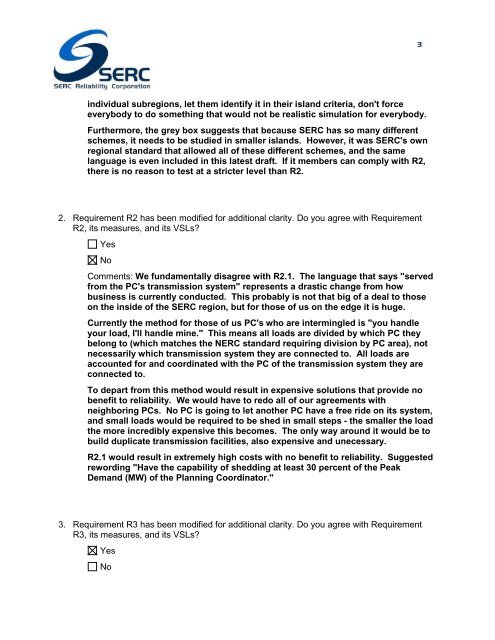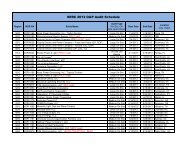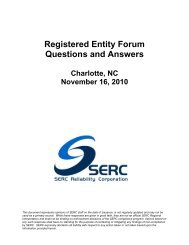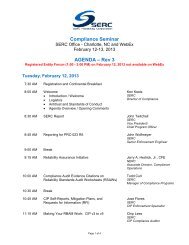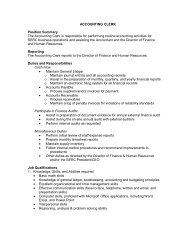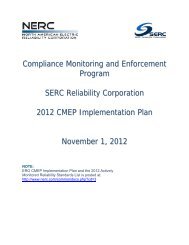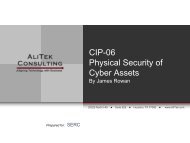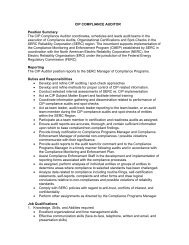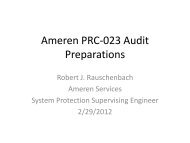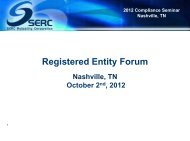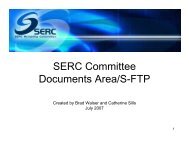Comments on Draft 7 SERC UFLS Standard_PRC-006-SERC-01_ ...
Comments on Draft 7 SERC UFLS Standard_PRC-006-SERC-01_ ...
Comments on Draft 7 SERC UFLS Standard_PRC-006-SERC-01_ ...
Create successful ePaper yourself
Turn your PDF publications into a flip-book with our unique Google optimized e-Paper software.
3individual subregi<strong>on</strong>s, let them identify it in their island criteria, d<strong>on</strong>'t forceeverybody to do something that would not be realistic simulati<strong>on</strong> for everybody.Furthermore, the grey box suggests that because <strong>SERC</strong> has so many differentschemes, it needs to be studied in smaller islands. However, it was <strong>SERC</strong>'s ownregi<strong>on</strong>al standard that allowed all of these different schemes, and the samelanguage is even included in this latest draft. If it members can comply with R2,there is no reas<strong>on</strong> to test at a stricter level than R2.2. Requirement R2 has been modified for additi<strong>on</strong>al clarity. Do you agree with RequirementR2, its measures, and its VSLs?YesNo<str<strong>on</strong>g>Comments</str<strong>on</strong>g>: We fundamentally disagree with R2.1. The language that says "servedfrom the PC's transmissi<strong>on</strong> system" represents a drastic change from howbusiness is currently c<strong>on</strong>ducted. This probably is not that big of a deal to those<strong>on</strong> the inside of the <strong>SERC</strong> regi<strong>on</strong>, but for those of us <strong>on</strong> the edge it is huge.Currently the method for those of us PC's who are intermingled is "you handleyour load, I'll handle mine." This means all loads are divided by which PC theybel<strong>on</strong>g to (which matches the NERC standard requiring divisi<strong>on</strong> by PC area), notnecessarily which transmissi<strong>on</strong> system they are c<strong>on</strong>nected to. All loads areaccounted for and coordinated with the PC of the transmissi<strong>on</strong> system they arec<strong>on</strong>nected to.To depart from this method would result in expensive soluti<strong>on</strong>s that provide nobenefit to reliability. We would have to redo all of our agreements withneighboring PCs. No PC is going to let another PC have a free ride <strong>on</strong> its system,and small loads would be required to be shed in small steps - the smaller the loadthe more incredibly expensive this becomes. The <strong>on</strong>ly way around it would be tobuild duplicate transmissi<strong>on</strong> facilities, also expensive and unecessary.R2.1 would result in extremely high costs with no benefit to reliability. Suggestedrewording "Have the capability of shedding at least 30 percent of the PeakDemand (MW) of the Planning Coordinator."3. Requirement R3 has been modified for additi<strong>on</strong>al clarity. Do you agree with RequirementR3, its measures, and its VSLs?YesNo


